The Crucial m4 (Micron C400) SSD Review
by Anand Lal Shimpi on March 31, 2011 3:16 AM ESTLast week I was in Orlando attending CTIA. While enjoying the Florida weather, two SSDs arrived at my office back in NC: Intel's SSD 320, which we just reviewed three days ago and Crucial's m4. Many of you noticed that I had snuck in m4 results in our 320 review but I saved any analysis/conclusions about the drive for its own review.
There are more drives that I've been testing that are missing their own full reviews. Corsair's Performance Series 3 has been in the lab for weeks now, as has Samsung's SSD 470. I'll be talking about both of those in greater detail in an upcoming article as well.
And for those of you asking about my thoughts on the recent OCZ related stuff that has been making the rounds, expect to see all of that addressed in our review of the final Vertex 3. OCZ missed its original March release timeframe for the Vertex 3 in order to fix some last minute bugs with a new firmware revision, so we should be seeing drives hit the market shortly.
There's a lot happening in the SSD space right now. All of the high end manufacturers have put forward their next-generation controllers. With all of the cards on the table it's clear that SandForce is the performance winner once again this round. So far nothing has been able to beat the SF-2200, although some came close—particularly if you're still using a 3Gbps SATA controller.
All isn't lost for competing drives however. While SandForce may be the unequivocal performance leader, compatibility and reliability are both unknowns. SandForce is still a very small company with limited resources. Although validation has apparently improved tremendously since the SF-1200 last year, it takes a while to develop a proven track record. As a result, some users and corporations feel more comfortable buying from non-SF based competitors—although the SF-2200 may do a lot to change some minds once it starts shipping.
The balance of price, performance and reliability is what keeps this market interesting. Do you potentially sacrifice reliability for performance? Or give up some performance for reliability? Or give up one for price? It's even tougher to decide when you take into account that all of the players involved have had major firmware bugs. Even though Intel appears to have the lowest return rate out of all of the drives it's not excluded from the reliability/compatibility debate.
Crucial's m4, Micron's C400
Micron and Intel have a joint venture, IMFT, that produces NAND Flash for both companies as well as their customers. Micron gets 51% of IMFT production for its own use and resale, while Intel gets the remaining 49%.
Micron is mostly a chip and OEM brand, Crucial is its consumer memory/storage arm. Both divisions shipped an SSD called the C300 last year. It was the first 6Gbps SATA SSD we tested and while it posted some great numbers, the drive launched to a very bumpy start.
| Crucial's m4 Lineup | ||||||||||||||
| CT064M4SSD2 | CT128M4SSD2 | CT256M4SSD2 | CT512M4SSD2 | |||||||||||
| User Capacity | 59.6GiB | 119.2GiB | 238.4GiB | 476.8GiB | ||||||||||
| Random Read Performance | 40K IOPS | 40K IOPS | 40K IOPS | 40K IOPS | ||||||||||
| Random Write Performance | 20K IOPS | 35K IOPS | 50K IOPS | 50K IOPS | ||||||||||
| Sequential Read Performance | Up to 415MB/s | Up to 415MB/s | Up to 415MB/s | Up to 415MB/s | ||||||||||
| Sequential Write Performance | Up to 95MB/s | Up to 175MB/s | Up to 260MB/s | Up to 260MB/s | ||||||||||
A few firmware revisions later and the C300 was finally looking good from a reliability perspective. Although recently I have heard reports of performance issues with the latest 006 firmware, the drive has been working well for me thus far. It just goes to show you that company size alone isn't an indication of compatibility and reliability.
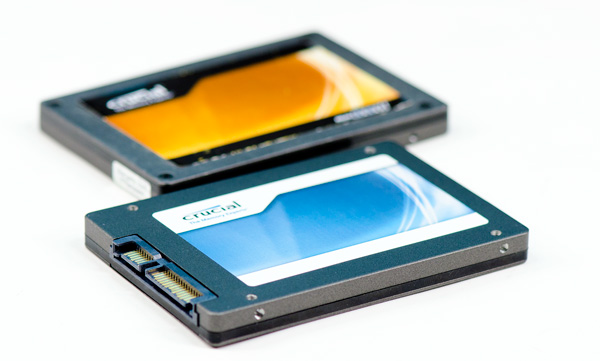
Crucial RealSSD C300 (back), Crucial m4 (front)
This time around Crucial wanted to differentiate its product from what was sold to OEMs. Drives sold by Micron will be branded C400 while consumer drives are called the m4. The two are the same, just with different names.
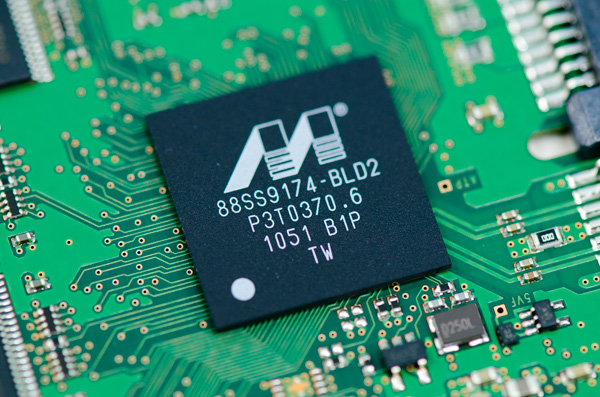
The Marvell 88SS9174-BLD2 in Crucial's m4
Under the hood, er, chassis we have virtually the same controller as the C300. The m4 uses an updated revision of the Marvell 9174 (BLD2 vs. BKK2). Crucial wouldn't go into details as to what was changed, just to say that there were no major architectural differences and it's just an evolution of the same controller used in the C300. When we get to the performance you'll see that Crucial's explanation carries weight. Performance isn't dramatically different from the C300, instead it looks like Crucial played around a bit with firmware. I do wonder if the new revision of the controller is at all less problematic than what was used in the C300. Granted fixing any old problems isn't a guarantee that new ones won't crop up either.
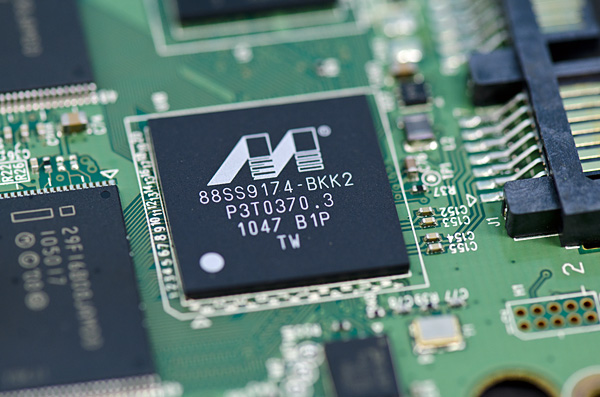
The 88SS9174-BKK2 is in the Intel SSD 510
The m4 is still an 8-channel design. Crucial believes it's important to hit capacities in multiples of 8 (64, 128, 256, 512GB). Crucial also told me that the m4's peak performance isn't limited by the number of channels branching off of the controller so the decision was easy. I am curious to understand why Intel seems to be the only manufacturer that has settled on a 10-channel configuration for its controller while everyone else picked 8-channels.
Crucial sent along a 256GB drive populated with sixteen 16GB 25nm Micron NAND devices. Micron rates its 25nm NAND at 3000 program/erase cycles. By comparison Intel's NAND, coming out of the same fab, is apparently rated at 5000 program/erase cycles. I asked Micron why there's a discrepancy and was told that the silicon's quality and reliability is fundamentally the same. It sounds like the only difference is in testing and validation methodology. In either case I've heard that most 25nm NAND can well exceed its rated program/erase cycles so it's a non-issue.
Furthermore, as we've demonstrated in the past, given a normal desktop usage model even NAND rated for only 3000 program/erase cycles will last for a very long time given a controller with good wear leveling.
Let's quickly do the math again. If you have a 100GB drive and you write 7GB per day you'll program every MLC NAND cell in the drive in just over 14 days—that's one cycle out of three thousand. Outside of SandForce controllers, most SSD controllers will have a write amplification factor greater than 1 in any workload. If we assume a constant write amplification of 20x (and perfect wear leveling) we're still talking about a useful NAND lifespan of almost 6 years. In practice, write amplification for desktop workloads is significantly lower than that.
Remember that the JEDEC spec states that once you've used up all of your rated program/erase cycles, the NAND has to keep your data safe for a year. So even in the unlikely event that you burn through all 3000 p/e cycles and let's assume for a moment that you have some uncharacteristically bad NAND that doesn't last for even one cycle beyond its rating, you should have a full year's worth of data retention left on the drive. By 2013 I'd conservatively estimate NAND to be priced at ~$0.92 per GB and in another three years beyond that you can expect high speed storage to be even cheaper. In short, combined with good ECC and an intelligent controller I wouldn't expect NAND longevity to be a concern at 25nm.
The m4 is currently scheduled for public availability on April 26 (coincidentally the same day I founded AnandTech fourteen years ago), pricing is still TBD. Back at CES Micron gave me a rough indication of pricing however I'm not sure if those prices are higher or lower than what the m4 will ship at. Owning part of a NAND fab obviously gives Micron pricing flexibility, however it also needs to maintain very high profit margins in order to keep said fab up and running (and investors happy).
The Test
| CPU |
Intel Core i7 965 running at 3.2GHz (Turbo & EIST Disabled) Intel Core i7 2600K running at 3.4GHz (Turbo & EIST Disabled)—for AT SB 2011, AS SSD & ATTO |
| Motherboard: |
Intel DX58SO (Intel X58) Intel H67 Motherboard |
| Chipset: |
Intel X58 + Marvell SATA 6Gbps PCIe Intel H67 |
| Chipset Drivers: |
Intel 9.1.1.1015 + Intel IMSM 8.9 Intel 9.1.1.1015 + Intel RST 10.2 |
| Memory: | Qimonda DDR3-1333 4 x 1GB (7-7-7-20) |
| Video Card: | eVGA GeForce GTX 285 |
| Video Drivers: | NVIDIA ForceWare 190.38 64-bit |
| Desktop Resolution: | 1920 x 1200 |
| OS: | Windows 7 x64 |


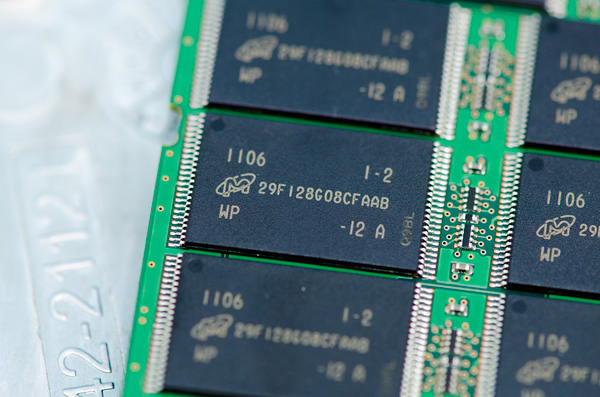
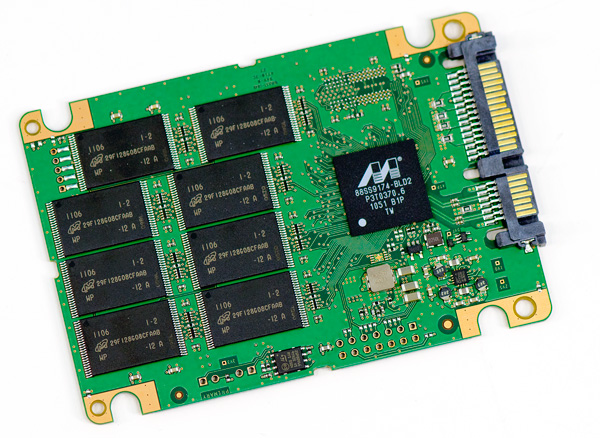
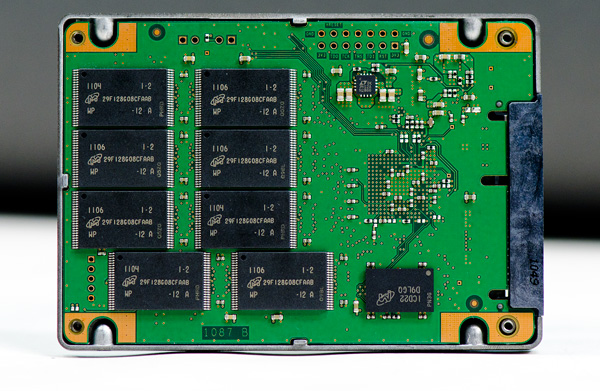








103 Comments
View All Comments
MrSpadge - Thursday, March 31, 2011 - link
Wait for the final hard- and software. Some power saving mode was probably not active in this beta version.MrS
Out of Box Experience - Friday, April 1, 2011 - link
The majority of users as of January 2011 were still using XP55% used XP
22% used Windows 7
So for the Majority of users, Intel's 320 series is still the best SSD to get as it uses the same OS agnostic controller that the last Intel SSD's
OCZ on the other hand just purchased Indilynx so we may yet see a OS agnostic controller from them in the near future to compete with Intel in the non-Windows 7 space
This would make perfect sense for OCZ to add the offset to Indilynx controllers to compete for XP users and keep the Sandforce line for Windows 7 users
Although Indilynx does not have the Raw throughput of a Sandforce SSD, it would give respectable performance on "ANY" OS without the need for partition hacks and should be suitable for dual boots if the proper offset is implemented
One of the most basic problems with partition offset hacks for XP was that the offset would be lost if you backup and restore a single partition using Acronis True Image
The only way to keep the offset would be to backup the entire drive!
O&O defrag Pro v14 has a "Manual" Trim command if anyone is interested ???
Controllers that do not include the proper offset for XP boxes generally have horrible "USED" performance after several writes but seem to function OK if you only use them for a boot drive and avoid writes (Hard to do with XP)
Out of Box Experience - Friday, April 1, 2011 - link
Correction:--------------
So for the Majority of users, Intel's 320 series is still the best SSD to get as it uses the same OS agnostic controller that the last generation Intel SSD's had
7Enigma - Friday, April 1, 2011 - link
Could you site your source for those numbers? My hunch is that the people still on XP are likely NOT the same people that will be purchasing these drives. More likely they are on Vista or Win7 which mainly negates your comment.Don't get me wrong I love XP still (my laptop and wife's computer are still running it), but for my main gaming rig (only system with a SSD) I've been through 2 OS revisions (Vista and now 7). Why? DX10/11 support.
And people upgrading existing systems for a SSD are likely upgrading for similar reasons. Few people are going to drop $100-400 for a SSD on a 3-5 year old computer. They are brainwashed into thinking the spyware/virii loaded system is slow because it's old, not because it just needs a fresh install and some proper lockdown/protection.
Out of Box Experience - Friday, April 1, 2011 - link
Sorry, I could not find the exact source that I used but here is a different one with similar resultshttp://www.winmatrix.com/forums/index.php?/topic/3...
Your hunch that people still using XP are likely NOT the same people that will be purchasing these drives is a good bet due to the fact that these drives tend to perform quit badly in a used state when compared to the Intel SSD's on an XP box
This is also the reason I think that OCZ may have purchased Indilynx
To add the offset needed to compete with Intel on the XP boxes
Even if Windows 7 had the same market share "TODAY" that XP enjoys, it is still foolish for SSD makers to ignore that huge XP market at their own detriment
Windows 7 may be the future, but there's gold in them thar XP hills
LeTiger - Thursday, March 31, 2011 - link
With the major players out of the woods now, I guess it's just time to wait until next year to see prices go down. Overall, I can't decide whether I'm happy over a (potentially) knockout performance by OCZ, or sad at the state of Intel/Crucial/etc... offerings...With prices where they still are at this point, I am very satisfied with my 30gb boot drive, and will continue to wait till costs go down until I convert fully over to the SSD realm...
Wave Fusion - Thursday, March 31, 2011 - link
I don't place much faith on that happening.SSDs are selling well enough there's not a good enough reason to reduce prices anytime soon.
At about $1 per GB most SSDs costs more than major parts like the CPU, GPU, RAM and HDD combined.
Allow me to pose a question for a general consensus: All and SSD does better is open files/programs faster and move large files (drive 1 to drive 2) faster; due to its high read/write speeds and more simultaneous operations.
BUT; if you've already run a program once since booting, closed it, then opened it again.. I thought the program was likely cached in the RAM. Which means an SSD would no longer improve anything
The only potential benefit past 1st run would be any data that's never rerun, like media encoding. But the often poorly designed/outdated single threaded programs themselves are a bottleneck way before a HDD is. At least on my machine, even similtaneous
So then I have to ask myself, assuming recently accessed files/programs cached in RAM isn't some myth; what do I really gain from using an SSD?
Why would I spend that money when I could instead use it for an even better GPU or something I actually will notice?
MilwaukeeMike - Thursday, March 31, 2011 - link
Valid point.. but when I use my PC i do a few things frequently that would benefit. I have a kid, and therefore lots of pics and videos, and i play some video games, so i deal with loading screens. I don't ever sit and wait and wish i had 100 FPS instead of my current avg 60. The only times i'm ever looking at my screen and waiting for my PC to finish doing something is either loading a webpage (1-2 seconds) or loading a game (often) or copying files (kinda rare).You're right, if you only use word and excel, this isn't for you. But if find yourself waiting for game screens to load it's worth it. Also, many people have already perfectly fast CPU's/GPU/s and good enough monitors.
The HD is the last slow piece of my computer for me to upgrade.
Ammaross - Thursday, March 31, 2011 - link
Yes, most CPUs bought within the last two years will be more than powerful enough to handle common use. Juicing a system with an SSD will be the best way to regain "lost" performance. Rather than telling your parents to get a new computer when their old one is just "too slow," upgrade their hard drive to an SSD. They likely don't reach 120GB as it is.LeTiger - Friday, April 1, 2011 - link
I would spend the money because for what I do, an SSD greatly benefits my workflow. Tooling around in Lightroom/CS5 all day benefits from an SSD. I just think they are still too much, and when they do get down to the $1 per gig, I will snatch up the biggest one I can afford.As far as "something you will actually notice", you couldn't be more mistaken, an SSD will make the biggest noticeable difference in performance in a computer that you will be able to see. As the comment below says, (and I agree), would you rather watch your FPS meter jump from 60 to 100? or have almost everything you do load very, VERY quickly.
- It made my intel Atom/ION laptop feel as fast as my Quad Core for light usage scenarios, now that is worth spending money on as peace of mind.